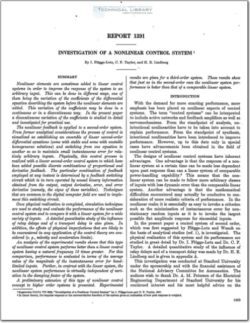NACA-Report-1391

- Version
- 99 Downloads
- 5.92 MB File Size
- 1 File Count
- December 4, 2015 Create Date
- December 4, 2015 Last Updated
National Advisory Committee for Aeronautics, Report - Investigation of a Non Linear Control System

Nonlinear elements are sometimes added to linear control
systems in order to improve the response of the system to an
arbitrary input. This can be done in different ways, one of
them being the variation of the coewficients of the dizferential
equation describing the system before the nonlinear elements are
’added. This variation of the coefi'icients may be done in a
continuous or in a discontinuous way. In the present paper
a discontinuous variation of the coefi‘icients is studied in detail
and investigated for practical use.
The nonlinear feedback is applied to a second-order system.
From former analytical considerations the process of control is
visualized as establishing an ensemble of linear second—order
difierential equations (some with stable and some with unstable
homogeneous solutions) and switching from one equation to
another so as to maintain small instantaneous error for rela-
tively arbitrary inputs. Physically, this control process is
realized with a linear second-order control system to which have
been added possible discrete combinations of proportional and
derivative feedback. The particular combination of feedback
employed at any instant is determined by a feedback switching
circuit which is in turn operated by sensed binary information
obtained from the output, output derivative, error, and error
derivative (namely, the signs of these variables). Techniques
that are common to the digital computer field are used to imple~
ment this switching circuit.
Once physical realization is completed, simulation techniques
are used to study and evaluate the performance of the nonlinear
control system and to compare it with a linear system for a wide
variety of inputs. A detailed quantitative study of the influence
of relay delays and of a transport delay is also given. In
addition, the ejects of physical imperfections that are likely to
be encountered in any application of the control theory are con—
sidered (e. g., velocity and acceleration limits).
| File | Action |
|---|---|
| naca-report-1391.pdf | Download |

Comment On This Post